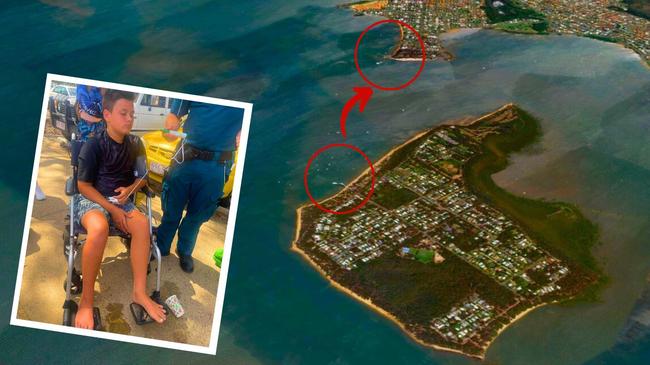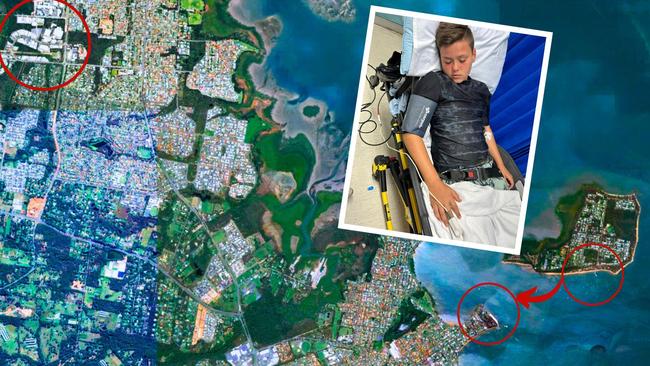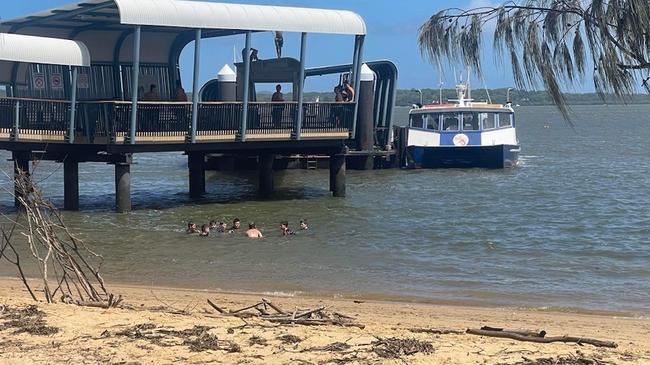Redland council issues stonefish alert after schoolboy stung at Coochiemudlo Island
A Redland schoolboy is lucky to be alive after being stung by one of the most venomous fish in the world, triggering an urgent warning from the local council to swimmers in Moreton Bay.

Redlands Coast
Don't miss out on the headlines from Redlands Coast. Followed categories will be added to My News.
A year 7 student is lucky to be alive after being stung by one of the most venomous fish in the world during a day out with school friends on a bay island, east of Brisbane.
Faith Lutheran College Redlands student Tyler Johnson was at Coochiemudlo Island on Thursday when he stepped on a stonefish and had to wait more than two hours to get back to the mainland.
Tyler was the third person to have been stung by a stonefish in waters off Redland’s bay islands in the past month, during strong rains and the highest tides for the year.
The wet conditions may have also played a part in three visitors to K’gari being stung by irukandji in the past two days.
A man was flown to a mainland hospital from K’gari after he was stung by an irukandji jellyfish at midday on Monday.
Redland City Council moved swiftly to alert visitors to the dangerous fish in waters off Coochiemudlo on Thursday.
Mum Michelle Johnson said her son had to wait on the island beach with his foot in a bucket of warm water to quell the pain because Queensland Ambulance Service officers missed the first car barge back to Victoria Point.
The ambulance officers opted to take an ambulance on the public car barge over using a water ambulance, which was docked on the island.

“QAS officers were treating Tyler on the beach but they missed the departing barge to the mainland and so had to wait for the barge to go all the way to Victoria Point and then come all the way back – which took more than an hour,” Mrs Johnson said.
“By the time we got to Redland Hospital it had been three hours.
“We were told that Tyler could not go in the water ambulance, even though it was already on the island, because that boat was unable to dock at Victoria Point.
“The officers said that the water ambulance would have to go all the way to Redland Bay and then an ambulance would have to meet him there to take him to Redland Hospital because the new satellite hospital was not an option.
“We were lucky that Tyler did not have an allergic reaction to the sting because that is when timing and hospital treatment is crucial.”
A Queensland Ambulance Spokesman said paramedics were on the island and able to provide immediate care to Tyler.
“In this incident, the barge was used to facilitate transport to the mainland and it operates on a schedule.”
Tyler spent six hours at Redland Hospital where his foot was X-rayed and he was treated for the excruciatingly painful stonefish sting before being released at 10pm.
He is recovering at home and being treated with painkillers and anti-inflammatories after his foot swelled to twice its normal size and the skin started to peel.
Tyler was the third person to be treated for a stonefish sting in Redland over the holidays after reports of a woman also stung at Coochiemudlo and a man at a beach at Raby Bay in December.

Mrs Johnson said there were no signs warning swimmers of the dangers of stepping on a stonefish at the beach at Coochiemudlo Island.
Redland City Council issued a Facebook warning on Friday to alert swimmers and a spokesman told Mrs Johnson that warning signs would be erected on the beach.
The council warning was issued after heavy rains which have stirred up coastal water flows and ahead of the last week of school holidays when the tides are the highest for the year with water covering parts of the beaches that are usually dry.
Queensland Health said stonefish stings can be fatal but there haven’t been any reported deaths in Australia.
According to Queensland Health, stonefish live all along the coast and some in freshwater.
Queensland Health recommends treating stings by immediately washing the wound where the spine of a stonefish or barb has pierced the skin.
Soak the affected area in hot, but not scalding, water, about 45C, for up to 90 minutes to help ease the pain.
Be careful with infants, the elderly, or people who have poor skin condition, as hot water may burn the skin.
For severe pain or a deep wound go to the nearest hospital immediately.
WHAT TO DO
■ Call Triple Zero (000), stonefish stings can be fatal. What you do next depends on where the bite is.
LEG STINGS
Call triple-0 (000) and apply a bandage and splint. Make sure the bandage is comfortable, as it will need to be worn until a doctor removes it. Apply the bandage even if the person is already ill from the poison.
Keep the person’s whole body still and don’t remove their clothing. Moving them may cause more venom to enter the blood stream.
Apply a broad pressure bandage over the bite site as soon as you can. Crepe bandages are best, but you can use any flexible material. For example, clothing or towels.
Bandage upwards from the lower part of the bitten leg.
Wrap it firmly without stopping blood circulation. It should be as tight as you would apply to a sprained ankle.
Wrap the bandage as high as possible up the leg.
Apply a splint to the leg. You can use any stiff object as a splint, for example, a piece of wood or tree branch, or rolled up newspaper.





